What is skin aging?
There are two types of aging processes: intrinsic and extrinsic aging.
- Intrinsic or chronological aging affects the skin of the entire body, including sites protected from the sun.
- Extrinsic aging is induced by chronic ultravioletUV) exposure to radiation, smoking and other pollutants, and overlaps the intrinsic aging process.
Signs of skin aging
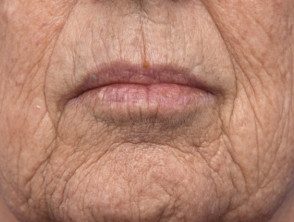
Skin aging
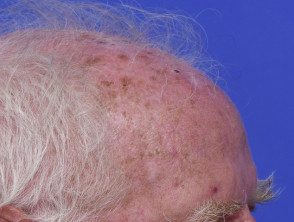
Skin aging
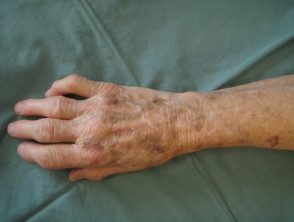
Skin aging
Who is affected by skin aging?
Intrinsic aging affects everyone, whatever their skin type. Extrinsic aging affects people who are chronically exposed to sunlight; this is known as sun damage or photoaging. People who generally have marked signs of photoaging include those who:
- Have Fitzpatrick sun-reactive skin types I-II (with red / blonde hair and blue eyes)
- Live in the tropics or subtropics.
- Live high
- Work outdoors or spend long periods outdoors for recreation
- Sometimes they have been exposed to artificial sources of UV radiation, such as indoor tanning
- Have a genetic predisposition to premature aging (eg, Progeria, which is rare).
Premature skin aging also affects tobacco smokers and those who have been chronically exposed to other environmental pollutants.
What makes the skin age?
Intrinsic aging is defined by the clinic, histological and physiological changes that occur in areas protected from the sun on the skin of older people. Intrinsic aging can be aggravated by other environmental factors.
Ultraviolet radiation
UV radiation attacks the integrity of the skin.
- It causes thousands of alterations in the DNA from each cell every day.
- The multiple shock model, which has been proposed to describe how UV radiation interacts with the components of the the extracellular matrix, results in the statement of a disorganized matrix, rich in elastic fiber (solar elastosis)
Menopause
The signs of intrinsic aging begin around 50-60 years. Women develop these signs earlier than men, which is attributed to a decrease in the protective effects of estrogen during menopause
Of smoking
Smoking exposes the skin to various harmful factors.
- Nicotine narrows blood vessels and blood flow, reducing the amount of oxygen and nutrients that reach the cells.
- Many other chemicals increase in tobacco smoke dermal MMPs and degrade collagen and elastin.
- The heat from cigarette burning and the facial muscle movements associated with smoking contribute to wrinkles.
- Chemicals like nitrosamines and tar are carcinogens.
Nutrition
Nutrition is known to affect extrinsic aging.
- Fruits, vegetables, legumes, herbs, and teas contain antioxidant compounds.
- Higher vitamin C levels and increased linoleic acid intake have been associated with decreased wrinkles, dryness, and atrophy of the skin
- In a nutritional study that recruited Greek, Australian, and Swedish subjects, resistance to photoaging was associated with increased intake of vegetables, olive oil, fish, and legumes, such as greaves, beans, peas, and lentils, and decreased intake of margarine. , sugar and dairy products.
- An increased intake of fats and carbohydrates has been associated with an increased risk of wrinkles and skin atrophy.
- Vitamin A, which can be applied topically (see our page Current retinoids), it has been observed that the production of MMP decreases.
- Consuming fish oil can also provide some sun protection.
Immune dysfunction
Skin aging can be a symptom of immunodeficiency diseases, immunosuppressive agents and chronic psychological stress.
What are the clinical characteristics of skin aging?
Intrinsic aging
Intrinsically aged skin looks dry and pale, smooth, thin, transparent and immaculate.
- It is finely wrinkled, due to the gravitational and conformational forces that determine how proteins fold.
- Sagging or lax skin can occur with body movement, due to loss of elasticity.
- The degrees of pigmentation on intrinsically aged skin they are very smooth and regular compared to photo-aged skin.
- Aging skin tends to develop a variety of benign neoplasms, as sebaceous hyperplasia and cherry angiomas.
-
Skin cancers are less common in intrinsically aged skin than in extrinsically aged skin.
- The skin surface maintains youthful geometric patterns.
Signs of intrinsic aging.
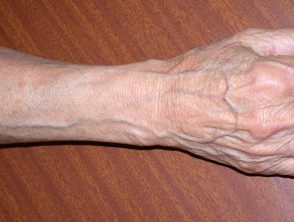
Thin skin

Guttate hypomelanosis

Telangiectasias
Extrinsic aging
Extrinsic aging, like photoaging, is related to environmental factors. Extrinsic aging was first reported in the late 19th century and was later described as "farmer's skin" or "sailor's skin."
- Extrinsic aging affects commonly exposed areas of the body, such as the individual's face, neck, and arms.
- Photodamage characteristics include roughness, sallow, deep wrinkles, dyspigmentationsenile purple, telangiectasia, and the development of a variety of benign and evil one skin lesions.
- Hyperpigmented injuries include diffuse mottled freckles lentiginesand seborrheic plane keratosis.
- Deep wrinkles are generally found on the individual's forehead and in the periorbital region.
Sun-induced cutaneous Changes vary considerably between individuals, reflecting inherent differences in vulnerability to sun exposure and reparative ability. Even among Caucasians, the appearance of photoaged skin of people with I-III skin phototypes often differs from that of people with IV-VI skin phototypes.
Fitzpatrick skin phototypes
| Type of skin | Skin color | UV effect |
|---|---|---|
| me | White or freckled skin | Always burns, never tans |
| II | White skin | Usually burns, tans badly |
| III | Olive skin | Sometimes it burns slightly, tans gradually |
| IV | Light brown leather | Rarely burns, easily tans |
| V | Dark skin | Very rarely burns, tan very easily |
| SAW | Dark skin | Never burns, tan very easily |
Ethnicity
The degree of photoaging is significantly affected by the ethnicity of an individual and the Fitzpatrick phototype. Light-skinned individuals of Northern European descent (Fitzpatrick I - III phototypes) are more prone to photoaging than individuals with colored skin (Fitzpatrick IV - VI phototypes, which include people of African, African American, Asian, and Latino descent) or Hispanic), with melanin offering protection against sun-induced damage.
Hypertrophic and atrophic photoaging
In white Caucasians, severe facial photoaging tends to produce two phenotypes:
- Hypertrophic photoaging: characterized by deep grooves and leathery appearance
- Atrophic Photoaging: Characterized by telangiectasia, a smooth, relatively wrinkle-free appearance, and the development of a variety of benign and malignant skin lesions.
People with Fitzpatrick III phototypes (and, to some extent, skin with IV phototype) tend to show hypertrophic responses; while those with phototypes I and II tend towards atrophic phenotype.
| Characteristics | Atrophic photoaging | Hypertrophic photoaging |
|---|---|---|
| Wrinkles | Minimum | Thick, deep |
| Texture | Smooth, slim | Rough, leathery |
| Appearance | Shiny skin | Sallow skin |
| Pigmentation | Focal depigmentation | Dyspigmentation |
| Vasculature | Telangiectasia and senile purpura are common | Minimal or absent vascular changes |
| Dysplastic changes | Actinic keratosis, basal cell carcinomas and scaly cell carcinomas are common | Actinic keratoses, basal cell carcinomas, and squamous cell carcinomas are rare. |
| Other | Poikiloderma by Civatte | Associated with Favre-Racouchot syndrome |
Extrinsic photoaging signs
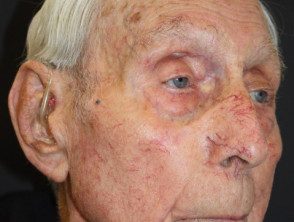
Atrophic photoaging
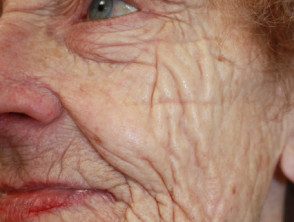
Hypertrophic photoaging
Dermatoporosis
Dermatoporosis is a term used to describe chronic skin failure and fragility associated with intrinsic and extrinsic aging. The characteristics of dermatoporosis include:
- Fragility and atrophy of the skin.
- Senile purple
- Starry pseudoscars (white star-shaped patches)
- Non-healing atrophic ulcers
- Hematoma dissection (bruises that extend under the skin)
- Delay in wound healing.
Signs of dermatoporosis.

Skin fragility
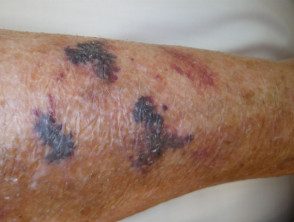
Senile purple
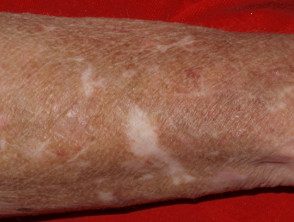
Starry pseudoscalar
How do we diagnose skin aging?
The characteristics of skin aging are clinically diagnosed. Suspicious skin lesions Cancer Present as lumps or growing sores that do not heal. Such injuries are often diagnosed biopsy before or as part of the treatment.
How do we treat skin aging?
Cancerous and precancerous injuries
-
Actinic keratoses and intraepidermal squamous cell carcinomas (SCC) are most often removed by cryotherapy or treated topically.
-
Basal cell carcinoma (BCC) is removed more frequently by minor surgery. Superficial BCC can be treated topically or by cryotherapy.
-
Cutaneous SCC and melanoma they are almost always removed surgically.
Dry and discolored skin
-
Moisturizers will help improve dry and flaky skin.
-
Alpha hydroxy acids, vitamin C, lipoic acid, soy isoflavones, or retinoid Regularly applied long-term creams reduce dryness. They can also reduce the amount of fine wrinkles and even remove pigmentation.
- Many other products are under investigation, but their benefits are unclear.
Facial rejuvenation
Procedures aimed at rejuvenating photoaged skin include:
-
Fillers (eg, Hyaluronic Acid, Polytetrafluoroethylene, and Fat Grafts) to disguise facial expression lines
-
Botulinum toxin injections to reduce frowning and decrease deep grooves
-
Vascular To be treatment and sclerotherapy (injection of inflammatory agent in veins) to remove facial veins and angiomas
- Repaving procedures (eg, Dermabrasion, chemical peel, and laser repaving)
- Cosmetic surgery to remove redundant sagging skin, including surgical or laser blepharoplasty for baggy eyelids, and meloplasty (facelift) to tighten the chins.
How do we prevent skin aging?
Intrinsic aging is inevitable. In perimenopausal women, systemic Hormone replacement can delay thinning of the skin; the skin is less dry, with fewer wrinkles, and wound healing is faster than before treatment. Hormone replacement is less effective in improving skin aging in the postmenopausal decades. Topical effects estrogens, phytoestrogens and progestins are under investigation
Protection against solar UV rays is essential at all ages. There are several steps that can be taken to minimize or avoid exposure to UV rays.
- Note the daily UV index levels. In New Zealand, comply with the advice provided by the Sun Protection Alert.
- Avoid outdoor activities during the middle of the day.
- Wear protective clothing from the sun (eg, a hat with a wide brim, long sleeves, and pants or skirts).
- Apply broad spectrum sunscreens with a very high sun protection factor (SPF> 30) exposed skin.
- Do not smoke and, where possible, avoid exposure to contaminants.
- Get plenty of exercise: Active people seem younger than inactive people.
- Eat fruits and vegetables daily.
Many oral supplements with antioxidants and anti-inflammatory Properties have been recommended to slow skin aging and improve skin health. These include carotenoids; polyphenols; chlorophyll; Aloe vera; vitamins B, C and E; red ginseng; squalene and omega-3 fatty acids. Its role in the fight against skin aging is unclear.
